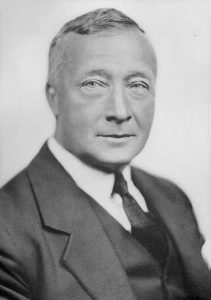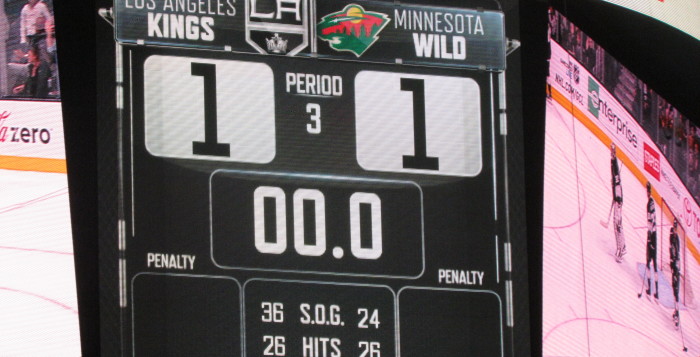This Day in Hockey History – November 21, 1942 – NHL Stops Working Overtime
War impacted hockey the way it affected almost everything else during the 1940s. Being able-bodied, athletic men, many players served for their countries. Trains and other public transportation options were needed for moving servicemen, so they had to run on schedule. The NHL had to take these issues into consideration when setting rules. As solutions, the NHL decided, on November 21, 1942, to eliminate overtime and then, two days later, the NHL reduced the minimum number of players required for each team’s roster.
The Montreal Gazette shared NHL President Frank Calder’s announcement regarding overtime play, and the major newspapers for the four U.S. cities with Original Six teams published variations of Montreal’s Associated Press (AP) story. Calder stated, “Due to wartime travel conditions games in which the score is tied at the end of the regulation 60 minutes will be regarded as draws and no overtime will be played.” Apparently, the trouble really stemmed from teams trying to leave New York City after games. Jack Adams, manager of the Red Wings, commented, “The overtime period was only 10 minutes, it is true, but it usually resulted in a half hour’s delay. Railroads will not hold trains for athletic teams nowadays, and so something had to be done.” Adams went even further saying “that he felt the abolition of the overtime period would meet with the approval of the public and become permanent.”

Frank Calder, via Wikimedia
Commons
Calder’s announcement also mentioned that “a proposal that rosters be cut will be reconsidered at a league gathering in Boston November 23.” On behalf of the Boston Bruins, Art Ross had proposed that instead of 15 players, rosters need only 13. Although the proposal had to do with the reduced number of players due to so many leaving for military service, Detroit blamed Boston for complaining because their team was short of players. Adams told the Detroit Free Press that he would vote against the measure like he had already earlier in the season.
The meeting, at Boston’s Copley-Plaza, was attended by Frank Calder, R.R. Duncan (Boston), Lester Patrick (NY), T.P. Gorman (Montreal), James Norris (Detroit), William J. Tobin (Chicago), and Frank J. Selke (Toronto). The end result was a compromise with team rosters being limited to 14 (instead of 15) players each game. In addition, the minimum number of players (12) was abolished, so a team could have as few as six players a game. Ross commented, “It’s certainly a step in the right direction.” Calder assured everyone, “Both of these changes have been made as wartime measures. They will remain in effect until further notice.” The new rule would go into effect that very night when the Bruins played the visiting Chicago Blackhawks. The Bruins would no longer be at a disadvantage, but other teams faced having to drop a player. For example, in Detroit “Johnny Holota, utility forward, will be cut from the roster and probably sent to Indianapolis.”
Three other rule changes were passed at the same meeting.
- If a player catches and drops the puck anywhere but directly at own feet, there will be a faceoff.
- If an official is hit with the puck, play continues from inside the penalty lines (rather than blue lines).
- “Faceoffs after intentional offsides shall be in the faceoff spots instead of at the blue line.”
Rather than being a temporary wartime measure, overtime was not reinstated for over 40 years. With the 1983-84 season, sudden death overtime was set for up to five minutes. The number of players who skated during overtime was reduced to four-on-four in 1999 and then down to three-on-three in 2015. As for players, the roster numbers did go back up after the war. The season before overtime returned, the NHL went up to its present mandates of at least a 20-player game roster (which must include two goaltenders) and a maximum 23-player active roster.
Additional Sources:
- “Calder Bans Overtime Play in N.H.L., to Consider Cut in Player Strength,” Montreal Gazette, 21 Nov. 1942, p. 16.
- “Hockey Overtime Periods Ruled Out for Duration,” Detroit Free Press, 21 Nov. 1942, p. 14.
- “Hockey Bans Overtime Play for Duration,” Chicago Tribune, 21 Nov. 1942, p. 20.
- “Overtime Hockey Out For Duration:Calder,” New York Daily News, 21 Nov. 1942, p. 25.
- “Overtime Play Out of Hockey for the Duration,” Boston Globe, 21 Nov. 1942, p. 8.
- Tom Fitzgerald, “Ross Hails Player Cut; B’s Tackle Hawks Here,” Boston Globe, 24 Nov. 1942, p. 24 (48).
- Tom Fitzgerald, “N.H.L. Player Limit Cut From 15 to 14,” Boston Globe, 24 Nov. 1942, p. 16.
- “Hockey Loop to Cut Rosters to 14 Players,” Detroit Free Press, 24 Nov. 1942, p. 17.














